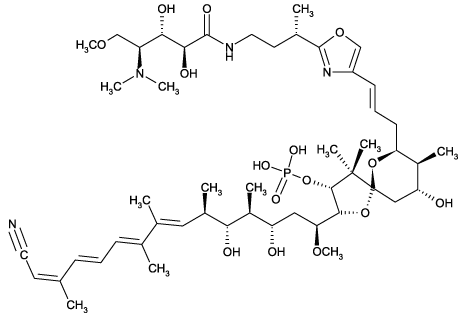Replaces Prod. #: ALX-350-014
- Highly specific, potent, and cell-permeable inhibitor of PP1 and PP2A
- Potent non-phorbol type tumor promoter
- Highly cited
Calyculin A is a cell-permeable and potent inhibitor with high specificity for protein phosphatase 1 (PP1) and 2A (PP2A). Treatment of MCF7 cells (breast cancer line) with 100nM of Calyculin A produced rapid (<20 min.) but incomplete inhibition of both PP1 (~60%) and PP2A (~70%). Calyculin A has no effect on acid or alkaline phosphatases at 1µM. Calyculin A inhibits p130cas tyrosine phosphorylation, enhances the phosphorylation level of NF-κB, affects intracellular signalling processes that require 14-3-3, prevents γ-radiation induced apoptosis, stimulates contraction of smooth muscle, induces intracellular protein phosphorylation in cultured human keratinocytes, and inhibits apoptosis.
Product Details
| Formula: | C50H81N4O15P |
| |
| MW: | 1009.2 |
| |
| CAS: | 101932-71-2 |
| |
| Purity: | ≥98% (HPLC, TLC) |
| |
| Appearance: | Clear film or white crystalline powder. |
| |
| Solubility: | Soluble in DMF, DMSO, or 100% ethanol. |
| |
| Shipping: | Ambient Temperature |
| |
| Long Term Storage: | -20°C |
| |
| Use/Stability: | Stable for at least 1 year after receipt when stored, as supplied, at -20°C. Stock solutions are stable for up to 3 months at -20°C. |
| |
| Regulatory Status: | RUO - Research Use Only |
| |
Please mouse over
Product Literature References
A mechanical G2 checkpoint controls epithelial cell division through E-cadherin-mediated regulation of Wee1-Cdk1: L. Donker et al.; Cell Rep.
41, 111475 (2022),
Abstract;
Effects of Calyculin a on the Motility and Protein Phosphorylation in Frozen-Thawed Bull Spermatozoa: H. Ogata, et al.; Zoolog. Sci.
38, 531 (2021),
Abstract;
JAK3 Is Expressed in the Nucleus of Malignant T Cells in Cutaneous T Cell Lymphoma (CTCL): C.K. Vadivel, et al.; Cancers
13, 280 (2021),
Abstract;
Full Text
MAP4K4 expression in cardiomyocytes: multiple isoforms, multiple phosphorylations and interactions with striatins: S.J. Fuller, et al.; Biochem. J.
478, 2121 (2021),
Abstract;
Full Text
Tyrosine phosphorylation of the myosin regulatory light chain controls non-muscle myosin II assembly and function in migrating cells: R. Aguilar-Cuenca, et al.; Curr. Biol.
30, 2446 (2020),
Abstract;
Full Text
Calyculin A induces apoptosis and stimulates phosphorylation of p65NF-kappaB in human osteoblastic osteosarcoma MG63 cells: H. Tanaka, et al.; Int. J. Oncol.
31, 389 (2007),
Abstract;
Calyculin A-induced vimentin phosphorylation sequesters 14-3-3 and displaces other 14-3-3 partners in vivo: G. Tzivion, et al.; J. Biol. Chem.
275, 29772 (2000),
Abstract;
Unique features of the okadaic acid activity class of tumor promoters: H. Fujiki & M. Suganuma; J. Cancer Res. Clin. Oncol.
125, 150 (1999), Review,
Abstract;
Inhibition of p130cas tyrosine phosphorylation by calyculin A: W. Qiu, et al.; J. Leukoc. Biol.
63, 631 (1998),
Abstract;
Differential inhibition and posttranslational modification of protein phosphatase 1 and 2A in MCF7 cells treated with calyculin-A, okadaic acid, and tautomycin: B. Favre, et al.; J. Biol. Chem.
272, 13856 (1997),
Abstract;
Differential toxicity of the protein phosphatase inhibitors microcystin and calyculin A: M.T. Runnegar, et al.; J. Pharmacol. Exp. Ther.
273, 545 (1995),
Abstract;
Calyculin A, a non-phorbol ester type tumor promotor, induced oxidative DNA damage in stimulated human neutrophil-like cells: T. Takeuchi, et al.; BBRC
205, 1803 (1994),
Abstract;
Potassium and calcium channel involvement in induction of long-lasting synaptic enhancement by calyculin A, a protein phosphatase inhibitor, in rat hippocampal CA1 region: N. Murakami, et al.; Neurosci. Lett.
176, 181 (1994),
Abstract;
Calyculin A, a potent inhibitor of phosphatases-1 and -2A, prevents apoptosis: Q. Song & M.F. Lavin; BBRC
190, 47 (1993),
Abstract;
Enhancement of AMPA-mediated synaptic transmission by the protein phosphatase inhibitor calyculin A in rat hippocampal slices: A. Figurov, et al.; Eur. J. Neurosci.
5, 1035 (1993),
Abstract;
Comparative effects of protein phosphatase inhibitors (okadaic acid and calyculin A) on human leukemia HL60, HL60/ADR and K562 cells: K. Sakurada, et al.; BBRC
187, 488 (1992),
Abstract;
Nonphorbol tumor promoters okadaic acid and calyculin-A induce membrane translocation of protein kinase C: R. Gopalakrishna; BBRC
189, 950 (1992),
Abstract;
Calyculin A, an inhibitor of protein phosphatases, a potent tumor promoter on CD-1 mouse skin: M. Suganuma, et al.; Cancer Res.
50, 3521 (1990),
Abstract;
Calcium-independent activation of contractile apparatus in smooth muscle by calyculin-A: H. Ishihara, et al.; J. Pharmacol. Exp. Ther.
250, 388 (1989),
Abstract;
Calyculin A and okadaic acid: inhibitors of protein phosphatase activity: H. Ishihara, et al.; BBRC
159, 871 (1989),
Abstract;
Codon 61 mutations in the c-Harvey-ras gene in mouse skin tumors induced by 7,12-dimethylbenz[a]anthracene plus okadaic acid class tumor promoters: H. Fujiki, et al.; Mol. Carcinog.
2, 184 (1989),
Abstract;
Protein phosphatases come of age: P.Cohen & P.T. Cohen; J. Biol. Chem.
264, 21435 (1989),
Abstract;
Full Text
The structure and regulation of protein phosphatases: P. Cohen; Ann. Rev. Biochem.
58, 453 (1989),
Abstract;
Okadaic acid: an additional non-phorbol-12-tetradecanoate-13-acetate- type tumor promoter: M. Suganuma, et al.; PNAS
85, 1768 (1988),
Abstract;
Related Products












